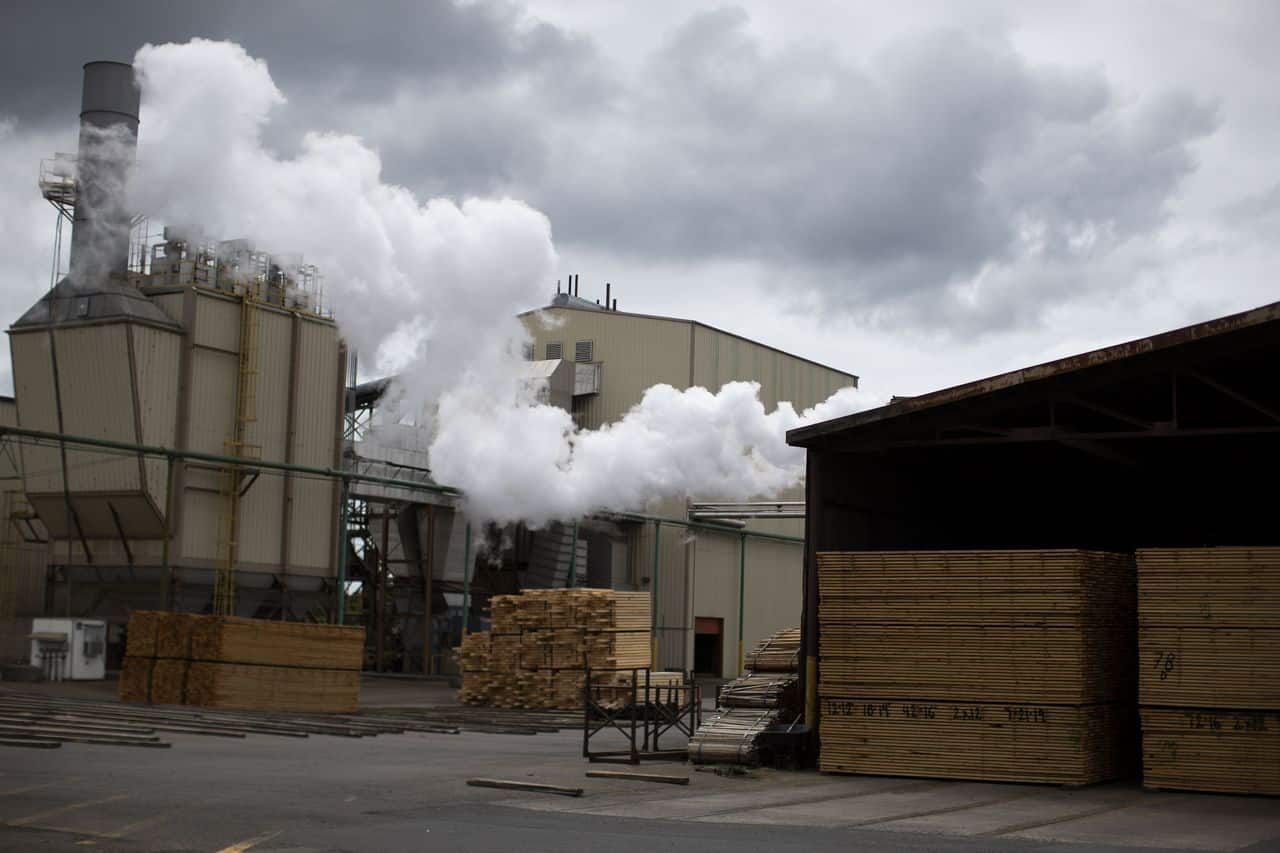
When Republican lawmakers walked out of the Oregon Capitol and brought an abrupt end to this year’s legislative session, a massive request from the Department of Forestry fell off the table.
Not even halfway through Oregon’s two-year budget cycle, the agency had blown through most of its money for the entire period and claimed it would run out entirely by May. State Forester Peter Daugherty says the agency needs between $52 million and $132 million.
The request would maintain the agency’s current programs and gird it through the upcoming fire season. However, the millions wouldn’t cover the expanded forest cleanup and wildfire prevention work that Gov. Kate Brown has pushed for based on recommendations from a wildfire council she empaneled last year.
It also doesn’t account for the coronavirus. The pandemic’s impact on the agency could be considerable, both financially and operationally.
The agency’s state and private forest divisions are funded almost entirely through harvest revenues from state forests and taxes on private logging. And with the pandemic’s vast economic fallout, Oregon’s wood products industry is already beginning to tank, erasing some of the best paid jobs in rural Oregon and dragging the agency’s revenues with it.
“April will be bad compared to March, and May will be a disaster,” said Andrew Miller, president of Stimson Lumber, one of the largest buyers of state forest logs.
Moreover, the concept of social distancing is antithetical to logging, not to mention wildland firefighting, where initial attack is almost always carried out by hand crews working closely together and living in tightly packed fire camps. Large fires often draw crews from around the country, even internationally, a potential risk in the current environment.
The pandemic is also happening in the heart of training season. Washington has already cancelled all three of its interagency fire academies, and it’s unclear what will happen with six weeks of fire academy scheduled to start in Salem during the first week of May.
Bobbi Doan, a spokeswoman for the forestry department’s fire division, said planning for fire season is well underway, and the division’s leaders — largely working from home — are grappling with those questions.
“We’re looking at all these issues as part of the readiness planning,” she said. “Public safety is priority No. 1, but we do know we’re going to have to respond.”
Industry slowdown
The wood products and logging sectors limped through the month of March, filling existing orders and supplying product for construction already underway. Gov. Kate Brown has deemed them essential industries. But that does little good if there’s nowhere to sell your product.
The construction industry has been shut down in Washington, in New England, in parts of Michigan and California – big markets that absorb a lot of wood from Oregon.
Steve Zika, the president of Hampton Lumber, says his company sells into several distinct markets. The home improvement store market for premium wood is still strong, he said, while demand for regular wood for building sites has collapsed.
“We were going to have an amazing housing year, but when all this started our order file began to evaporate,” he said. Hampton is shutting two of its nine mills next week, and will reevaluate on a week-to-week basis.
“I’d be surprised if you didn’t see some form of curtailment for almost everyone,” he said. “You can only stack your lumber for so long.”
Seneca Sawmill, which employs 470 in Eugene and Noti, is curtailing hours at its three mills in Eugene and closing down its log yard. The company is trying to get employees 30 hours a week, but in some cases that means bringing crews in to power wash and paint, not process logs. It has handed out bags of groceries to employees and is paying all health care premiums for April and May.
“We’re just trying to stay nimble,” said Casey Roscoe a senior vice president. “We have a meeting weekly. It’s that touch and go right now.”
The Swanson Group suspended production at its Glendale plywood plant, laying off about 300 people who work there. It is still operating its Roseburg and Springfield facilities, where it has a combined 400 employees. But “we are evaluating the situation daily and will adjust as needed,” said Steve Swanson, the company’s chief executive.
Miller, at Stimson Lumber, says many mills will continue operating at a loss for some time to maintain cash flow, the workforce and the infrastructure. When you wind down, he says, it’s tough to bring it back up.
Miller said his company’s mills typically carry four to six weeks of log inventory, but he says they could shut their yards today and operate for months without running out. They also don’t want to sit on material that will deteriorate over the summer months.
That reality is felt immediately upstream by loggers and truckers, who tend to be smaller, family owned businesses that operate on thin margins, carry significant debt on their machinery, and struggle to maintain good crews even when times are good.
Mike Pihl, who employs 19 at his logging outfit in Vernonia, says the market for cedar and utility poles is still good, but he’s running out of jobs that have that material. He typically has five or six jobs going at once, but by Monday several of them will be fully on hold.
“There’s no place to sell the logs coming off those jobs, so we just have to put ‘em in a deck and let ‘em lay,” he said. “It costs us about $5,000 a day to run an active logging site. I have a high debt load like every other logger, so it doesn’t take long to take me down. We’re paycheck to paycheck. We need cash flow.”
With social distancing, the logging that is happening can be more expensive, too. Instead of sticking six loggers in a truck and driving into the woods, you might need six separate vehicles to comply.
“Some of that is going on, but typically these guys don’t have the margin to absorb that, so they lay ‘em off and they’re not working,” said Rex Storm, interim executive vice president at Associated Oregon Loggers. “Once you lose that employee, they may never come back to you, so you’re without the most important asset, a productive, well-trained crew, when things get going again.”
Greg Schmitz, whose Silverton logging company has about 25 employees, says he typically runs two crews working for Weyerhaeuser, his largest customer, and another that logs for small woodland owners.
Before COVID-19, he says he had lots of work lined up for small landowners. But he said those jobs have dried up completely as landowners, who count on a big payday after decades of growing trees, are unwilling to accept the low “gate prices” that mills are currently offering.
Commodity lumber prices have dropped by 45% since the end of February. Gate prices, which fluctuate daily, have not seen that level of decline, but are also down significantly.
Schmitz says he hasn’t had to lay anyone off — yet. He’s doubling up crews on some jobs and putting people to work in the shop repairing equipment. Weyerhaeuser is a lifeline.
“We’re on quotas with them. They’re doing everything they can to keep us working. They understand the importance of keeping a stable workforce.
“It’s day-to-day,” he said. “You can’t make any long-term plans.”
State forestry woes
Sooner or later, the industry downturn will fold back on the Oregon Department of Forestry and exacerbate its ongoing financial problems. The state typically markets tracts of timber on state forests in good times and bad, which is good for mill owners who rely on that dependable supply. But beyond the deposit it requires from winning bidders, the agency doesn’t get paid until the trees are actually cut.
If mills shutter their log yards, those buyers are likely to leave the trees standing, further undermining the agency’s revenues and cash reserves it relies on to float other expenses, such as wildfire costs. Some buyers are already asking the agency for extensions on their timber purchases, which require the winning bidder to cut the trees within two to three years,
Agency officials had projected total harvest revenues of $125 million in 2020. They figured the state would break even on its expenses after sending two-thirds of the money to counties where the logging takes place — the standard revenue split. In the first quarter, timber revenues were actually running 23% ahead of projection.
But in a memo to the legislature’s budget committee chairs this week, Daugherty said “the likelihood of these projections staying firm are questionable due to current events.”
Revenues in the state forest division will likely decrease as timber prices fall, and as buyers make decisions on how much of the timber they’ll go ahead and cut, Daugherty said. Meanwhile, the private forest division will “undoubtedly see reductions in the harvest tax revenues” as timber operations are affected.
“Whether these market swings are solely the result of the economic impact of the COVID-19 pandemic, a cyclic adjustment in the timber industry, or both, there will be an effect on the department within the coming months,” he said.
In the meantime, the agency is seeing increased expenses related to COVID-19. It has provided 15 to 20 of its incident managers to the Office of Emergency Management’s coronavirus response team. And it is ramping up spending on fire season readiness, and those costs have gone up due to the virus, too.
Daugherty said the agency needs to have adequate resources available, but is expecting very limited access to national firefighting resources or crews from other states. It is also planning for a possible reduction in its own firefighting forces due to illness.
Fire season is always unpredictable. The agency developed its budget request assuming that at a bare minimum, it would cost $20 million. But since 2013, those costs have averaged $72 million a year. It’s not clear how much the legislature will be willing to pony up in advance, but it’s increasingly unlikely that the agency can rely on its cash reserves — mostly from timber sales — as a backstop.
Jason Cox, a spokesman for the state forest division, said recently that the division was in process of revising its forecasts to understand short term effects and prepare for the long term.
“This situation is moving rapidly,” he said, “and we’ve never encountered such a rapid change in the timber market.”
Vietnam Film Faced Plywood
Vietnam Plywood










